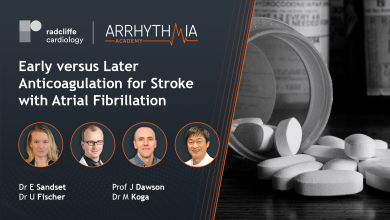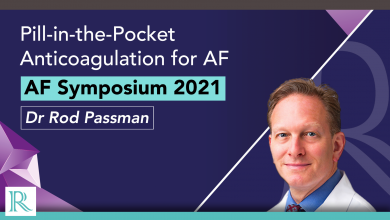Search results
Author(s):
Yousif Ahmad
,
Gregory YH Lip
Added:
3 years ago
Atrial fibrillation (AF) leads to a prothrombotic state1 and places patients at risk of thromboembolic disease. The most common and serious complication of thromboembolism is stroke, and AF is held responsible for 25 % of all strokes.2 Strokes in the context of AF are associated with a higher mortality, longer hospital stay and lower levels of independence at discharge.3 These factors combine to…
View more
Anticoagulation for Stroke Prevention
Author(s):
Amit Mistri
Start date:
Apr 02, 2015
Broadcast
Author(s):
Demosthenes G Katritsis
,
Bernard J Gersh
,
A John Camm
Added:
3 years ago
Thrombotic material in atrial fibrillation(AF) usually develops in the left atrial appendage as a result of decreased flow and stasis, possible endothelial dysfunction and a hypercoagulable state as indicated by increased fibrinogen, D-dimer, thromboglobulin and platelet factor 4 levels.1 In the Framingham Heart Study, the percentage of strokes attributable to AF increases steeply from 1.5 % in…
View more
Author(s):
C Fielder Camm
,
A John Camm
Added:
3 years ago
Hypertrophic cardiomyopathy (HCM) is a common genetic cardiac disorder, with an autosomal dominant mechanism of inheritance.1,2 It has a prevalence of 1 in 500 within the general population, and is a known cause of sudden cardiac death.2,3 Recognised autosomal dominant mutations within sarcomere proteins are found in 55 % of adolescents with sporadic HCM.4 Characteristic echocardiographic…
View more
Author(s):
Philipp Bushoven
,
Sven Linzbach
,
Mate Vamos
,
et al
Added:
3 years ago
Atrial Fibrillation, Cardioversion and Stroke Risk
Atrial fibrillation (AF) is the most common serious chronic heart rhythm disorder with an estimated prevalence in the general population of around 1%.1 The arrhythmia affects about 2.2 million persons in the US and 4.5 million individuals in the EU. Due to the advancing age of the population, the prevalence of AF is likely to increase even…
View more
Author(s):
Paulus Kirchhof
Added:
7 months ago
ESC 2023 — Prof Paulus Kirchhof (University Heart & Vascular Center Hamburg, DE) discusses the findings of the NOAH-AFNET 6 trial (NCT02618577).
NOAH-AFNET 6 (Atrial Fibrillation Network, Daiichi Sankyo Europe) was an investigator-initiated, prospective, randomised trial aiming to demonstrate that oral anticoagulation using the NOAC edoxaban is superior to current therapy in stroke prevention,…
View more
Author(s):
Freek WA Verheugt
Added:
8 years ago
Author(s):
Else Sandset
,
Jesse Dawson
,
Urs Fischer
,
et al
Added:
9 months ago
Dr Else Sandset (Oslo University Hospital, NO) is joined by Prof Jesse Dawson (University of Glasgow, GB), Dr Urs Fischer (University Hospital Basel, CH) and Dr Masatoshi Koga (National Cerebral and Cardiovascular Center, JP) to discuss the findings from their recent paper on "Early versus Later Anticoagulation for Stroke with Atrial Fibrillation" published in the New England Journal of Medicine…
View more
Author(s):
Rod S Passman
Added:
3 years ago
Dr Rod Passman (Northwestern Memorial Hospital, Chicago, IL, US) talks about “pill-in-pocket” anticoagulation for atrial fibrillation. In this short summary, he compares the results of the REACT.COM and TACTIF-AF pilot studies and discusses the REACT-AF study.
The REACT-AF poses the question of whether we can leverage the advances in both wearable technology and pharmacology with a rapid onset…
View more
Author(s):
Pascal Vranckx
,
Marco Valgimigli
,
Hein Heidbuchel
Added:
3 years ago
Anticoagulation with vitamin K antagonists (VKAs) has been used for the long-term treatment and prevention of thromboembolic diseases and for stroke prevention in atrial fibrillation (AF) for the past half century. Until the last decade, VKAs were the only oral anticoagulant (OAC) agents available, and warfarin remains the most commonly prescribed OAC worldwide.1 Direct oral anticoagulants (DOACs…
View more

















